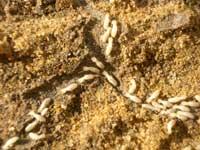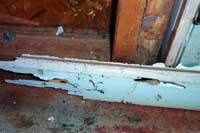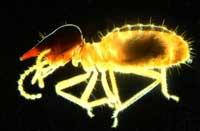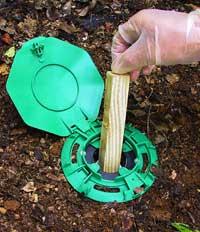Tok-tok! The termites arrive

In Europe there are three species of termites. But it should be noted that termites are many types of insects: in general, many of these are included in the termite group.
As we have said, termites sound when they eat wood. This sound makes him vibrate the wood with big jaws. A recent research has found that termites choose the wood they eat according to this sound, since there are termites specialized in the consumption of large portions of wood and, on the contrary, they prefer smaller portions of wood. Well, depending on the size of the wooden portion, the vibration is different, so the sound tone they pull out is more or less high. Thus, the termites choose the wood of the tone they like.
In this study, the tone of sound that is extracted with pieces of pine wood of different sizes has been measured: It ranges from 7.2 to 2.8 kilohertz. Large parts produce vibrations of less frequency, since in some way it is lost in the length of the wood. Well, the termite used in the research, which has been carried out in Australia, has used a kind of termites, Cryptotermes domesticus, which prefers pieces of wood that extracted high tone vibrations, that is, small portions of wood.
It seems that another species that lives around this species of termites prefers the largest fragments, thus avoiding competition.

This sound emitted by termites when eating in general attracts the rest of the workers of the colonic termite. In fact, termites receive a vibration in the legs and antennas, and following the vibration they can reach that sweet wood. Some experts believe that this rapid movement of wood when eating is also used to warn the members of the thermia of dangers.
Well organized in Termicina
In any case, small pieces of wood can be transported more easily to the thermia, where much of the colony is waiting for food brought by the workers. Termites are well organized insects. Like bees and ants, they have different social levels: the queen, the soldiers and the aforementioned workers, in charge of bringing food to the thermia.
The main task of the soldiers is to protect the termitatory. Therefore, they have a physical characteristic that separates them from the staff: strong and fearsome jaws. If an enemy attacks the colony, soldiers are indispensable, but they cannot feed themselves, so they need the help of the workers.

The obligation of kings is very different: to reproduce. And for this reason, in the center of the termitatory they are well protected. The queens of some species of termites can live up to 25 years, in which they can burn 60 thousand eggs. From these eggs come the workers and soldiers who form the colony, as well as the kings who will form in the future the new thermofamics.
The young monarchs are usually dark (the workers are white) and have wings, so they fly out of the ‘parents’ house. They usually fly by couples, which is one of the few possibilities that are given to see termites, which remain hidden in the rest, and when the opportune moment arrives they descend and multiply. To do this, they choose wet soil, preferably in a place of dead wood, forming a new colony.
From that moment, it is difficult to see the termites again. We also have them at home. In fact, the termitatory is located under the floor and the termite workers climb up the beams of the house in search of food. By the time you hear Tok-tok-to is too late, probably the entire termite colony is eating the wooden structure of the house.
Woodcutters, shepherds

In Euskal Herria the most damaged termites are produced in the hamlets and in the houses of the old villages, in buildings built in wood. But they are also included in more recent buildings: they are found with treasure climbing through cement nests: wooden earth or furniture.
However, they cause damage to public heritage, such as emblematic buildings, works of art and even archives. It must be taken into account that the paper is made from the cellulose of the wood, so the termites also consume paper.
In the large libraries and the archives in which many documents are kept, the fears are put to dance when they hear the word termita and, of course, in the silence of the night, when they realize that tok-tok-tok, the termites have entered without cutting. They dance, yes, but not because it rejoices the melodies of the termite drum.
Published in 7K.
Buletina
Bidali zure helbide elektronikoa eta jaso asteroko buletina zure sarrera-ontzian











